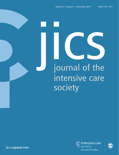
Journal of the Intensive Care Society
Scope & Guideline
Connecting Research and Practice in Critical Care
Introduction
Aims and Scopes
- Critical Care Medicine Research:
The journal publishes original research articles that explore various aspects of critical care medicine, including the management of critically ill patients, treatment protocols, and innovative approaches to care. - Multidisciplinary Collaboration:
Emphasizing the importance of teamwork in intensive care, the journal often features studies that involve various healthcare professionals, including nurses, doctors, and allied health staff, to enhance patient care. - Clinical Guidelines and Protocols:
The journal provides a platform for the dissemination of clinical guidelines, protocols, and best practices aimed at standardizing and improving care in intensive care units. - Psychosocial Aspects of Critical Care:
The journal recognizes the importance of mental health and well-being among patients and healthcare providers, featuring studies that address psychological interventions and the impact of critical illness on mental health. - Technological Innovations in Critical Care:
Research on the application of new technologies, such as point-of-care ultrasound and telemedicine, is a key focus, highlighting advancements that can enhance patient monitoring and treatment.
Trending and Emerging
- COVID-19 and Its Impact on Critical Care:
Research related to the management of COVID-19 patients in intensive care has surged, focusing on treatment protocols, long-term outcomes, and the psychological impact of the pandemic on healthcare workers and patients. - Patient-Centered Care and Recovery Journeys:
There is an increasing emphasis on understanding the patient experience, including recovery journeys and post-intensive care syndrome, highlighting the importance of holistic approaches to patient care. - Telemedicine and Remote Monitoring:
The adoption of telemedicine and remote monitoring technologies has gained momentum, driven by the need for efficient patient management during crises and the desire to improve access to critical care services. - Mental Health Interventions in Critical Care:
Research exploring mental health interventions for both patients and healthcare professionals is on the rise, recognizing the psychological toll of critical illness and the importance of staff well-being. - Sustainability in Intensive Care Practices:
Emerging themes around sustainability and environmental impact within intensive care settings are being explored, with a focus on reducing the carbon footprint of healthcare practices.
Declining or Waning
- Traditional Respiratory Therapies:
There has been a noticeable decline in studies focusing on conventional respiratory therapies, such as manual ventilation, as attention shifts towards more advanced techniques like non-invasive ventilation and ECMO. - Generalized Clinical Trials:
The journal has seen a decrease in publications related to generalized clinical trials not specific to intensive care settings, as there is a growing emphasis on targeted, condition-specific research. - Basic Nutritional Studies:
Research focusing solely on basic nutritional interventions in critically ill patients is becoming less frequent, with a shift towards more complex studies that integrate nutrition with overall patient management strategies. - Non-urgent Surgical Interventions:
There has been a noticeable reduction in publications discussing non-urgent surgical interventions within intensive care, as the focus has shifted to urgent and emergent care scenarios, particularly in light of recent global health crises. - Historical Perspectives on Critical Care:
Articles providing historical analyses of critical care practices are becoming less common, as the journal prioritizes contemporary research and innovative practices that address current challenges in intensive care.
Similar Journals
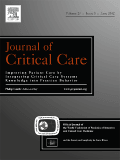
JOURNAL OF CRITICAL CARE
Advancing Critical Care Knowledge for a Healthier TomorrowJOURNAL OF CRITICAL CARE, published by W B SAUNDERS CO-ELSEVIER INC, is a prestigious peer-reviewed journal in the field of critical care and intensive care medicine. With an impressive Q1 classification in 2023, it stands as a leading publication among its peers, ranking #12 out of 110 in the Scopus database, which places it in the 89th percentile of critical care-related journals. Established in 1986 and with a converged timeline extending to 2025, the journal serves as a critical resource for international researchers, healthcare professionals, and students dedicated to advancing practices and understanding within the realm of critical care. Although it does not offer Open Access, the journal provides high-quality, rigorously reviewed articles that address contemporary issues, innovative techniques, and groundbreaking research in critical care medicine. By fostering scholarly dialogue and disseminating new knowledge, the JOURNAL OF CRITICAL CARE is pivotal in shaping the future of intensive patient care and enhancing health outcomes.

Journal of Emergencies Trauma and Shock
Transforming trauma response with cutting-edge insights.The Journal of Emergencies Trauma and Shock, published by Wolters Kluwer Medknow Publications, is a premier open-access journal dedicated to advancing the field of emergency medicine. With an ISSN of 0974-2700 and an E-ISSN of 0974-519X, this journal has been a vital resource since its inception in 2008, providing a platform for original research, reviews, and clinical studies pertinent to trauma and shock management. The journal is recognized for its significant contributions to the field, illustrated by its strong standing as a Q2 journal in Emergency Medicine and ranking #34/109 in Scopus, with a commendable 69th percentile. Based in Mumbai, India, the journal not only reaches local practitioners but also caters to an international audience with its commitment to disseminating high-quality research that influences practice and policy in emergency settings. The publication is especially respected for its innovative approaches and practical findings that inform healthcare professionals on the front lines of trauma care. Researchers, practitioners, and students alike will find invaluable insights and data that help to shape the future of emergency medicine.

INTENSIVE CARE MEDICINE
Transforming Critical Care Through Groundbreaking ResearchINTENSIVE CARE MEDICINE is a premier academic journal in the field of critical care and intensive care medicine, published by SPRINGER. With an impressive HIndex and a remarkable impact factor, this journal consistently ranks in the top quartile of its category, achieving Q1 status for 2023. Spanning over four decades since its inception in 1977, it serves as a crucial platform for disseminating groundbreaking research and clinical advancements that shape the future of intensive care. Notably, it holds a distinguished position in the Scopus rankings, placed #1 out of 110 in its field, reflecting its importance and influence among researchers and clinicians alike. Although it is not an open-access journal, it offers various subscription options, ensuring wide accessibility to its high-quality content. The journal is dedicated to enhancing knowledge and practices within the critical care community, making it an indispensable resource for practitioners, researchers, and students pursuing excellence in intensive care medicine.

Critical Care and Resuscitation
Uniting scholars to enhance the future of patient care.Critical Care and Resuscitation is a premier peer-reviewed journal published by Elsevier, focusing on the dynamic fields of Anesthesiology, Critical Care, and Emergency Medicine. Established in Australia, this journal has been a significant contributor to scholarly research since its inception in 1999, maintaining a strong reputation with a commendable impact factor, evidenced by its Q1 quartile rankings across its relevant categories for 2023. The journal's commitment to disseminating high-quality research is reflected in its elite standings: it ranks #7 out of 109 in Emergency Medicine, #12 out of 136 in Anesthesiology, and #16 out of 110 in Critical Care. Aimed at researchers, clinicians, and healthcare professionals, Critical Care and Resuscitation provides a vital platform for the latest advancements in patient care and clinical strategies, making it an essential resource for those eager to stay at the forefront of these critical disciplines. Although lacking Open Access options, its rigorous peer-review process ensures the publication of valuable insights that shape current practices and influence future developments in healthcare.

Netherlands Journal of Critical Care
Advancing Knowledge in Critical CareThe Netherlands Journal of Critical Care, an esteemed publication of the NETHERLANDS SOC INTENSIVE CARE, serves as a vital resource for those in the fields of critical care and intensive medicine. As a platform focused on disseminating high-quality research from 2008 to 2023, this journal provides critical insights and advancements pertinent to the rapidly evolving landscape of intensive care practices. Though categorized in the fourth quartile for Critical Care and Intensive Care Medicine in 2023, its commitment to enhancing patient outcomes remains unwavering. With an ISSN of 1569-3511, this journal invites submissions that push the boundaries of knowledge and offer innovative approaches to critical care challenges. Thus, it is an essential reference for researchers, healthcare professionals, and students eager to stay at the forefront of critical care developments in the Netherlands and beyond.

Trends in Anaesthesia and Critical Care
Innovating practices for optimal patient outcomes.Trends in Anaesthesia and Critical Care, published by ELSEVIER SCI LTD, is a pivotal journal in the fields of anesthesiology, pain medicine, and critical care, providing a comprehensive platform for the dissemination of innovative research and clinical advancements. With an ISSN of 2210-8440 and an E-ISSN of 2210-8467, this journal boasts a notable presence in the academic landscape, holding a respectable Q3 ranking in both anesthesiology and critical care categories as of 2023. The journal caters to a diverse audience of researchers, practitioners, and students seeking to stay abreast of the latest trends and breakthroughs from its inception in 2011 until 2024. While it is not an open access journal, its rigorous peer-review process ensures that all published articles meet the highest academic standards, making it a trusted resource for evidence-based practices in anesthesiology and critical care management. As the landscape of these vital medical fields continues to evolve, Trends in Anaesthesia and Critical Care remains an indispensable resource, fostering a community dedicated to enhancing patient outcomes through scholarly exchange.
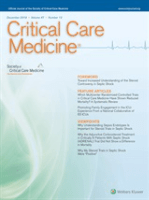
CRITICAL CARE MEDICINE
Unveiling Breakthroughs in Intensive Care MedicineCRITICAL CARE MEDICINE is a premier journal dedicated to the advancement of knowledge and practice in the field of critical care and intensive care medicine. Published by Lippincott Williams & Wilkins, this distinguished journal has been at the forefront of medical research since its inception in 1973, and it continues to offer insights into the latest developments and innovations in critical care. With a remarkable ranking of #5 out of 110 in Scopus' Critical Care category and a 95th percentile rating, CRITICAL CARE MEDICINE is a leading source for high-impact research, reviews, and clinical studies. The journal is recognized as a Q1 publication, underscoring its authoritative presence within the academic community. Researchers and clinicians are encouraged to engage with cutting-edge findings that aim to improve patient care and outcomes. Although the journal is not open access, it remains an essential resource for professionals seeking to enhance their understanding and application of critical care practices.
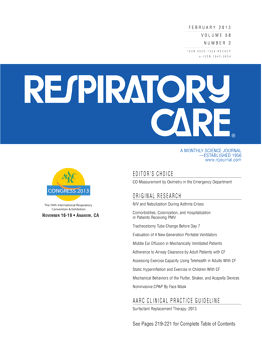
Respiratory Care
Elevating Standards in Critical and Pulmonary Care.Respiratory Care is a leading journal in the fields of Critical Care, Intensive Care Medicine, and Pulmonary and Respiratory Medicine, published by DAEDALUS ENTERPRISES INC. With a history dating back to 1973 and continuing through 2024, this journal serves as a vital platform for disseminating innovative research findings, clinical practices, and advancements in respiratory healthcare. The journal is recognized for its impact, reflected in its impressive Q2 quartile rankings across several categories in 2023, demonstrating its relevance and influence in the medical community. Although it is not an Open Access publication, it provides critical insights and foster discussions aimed at enhancing patient care and treatment protocols for respiratory diseases. The journal is indexed in notable databases, ensuring wide visibility and accessibility of its content to researchers, professionals, and students dedicated to advancing knowledge and practice in respiratory care.
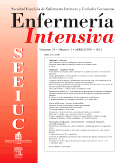
Enfermeria Intensiva
Elevating Patient Care with Specialized Nursing ResearchEnfermeria Intensiva, published by Elsevier Science Inc, is a highly regarded journal in the fields of Advanced and Specialized Nursing as well as Critical Care and Intensive Care Medicine. With an impressive track record spanning from 1994 to 2024, this journal serves as a vital resource for researchers, healthcare professionals, and students dedicated to enhancing the quality of patient care in critical settings. It holds a coveted Q2 ranking in multiple nursing categories as of 2023, reflecting its influence and contribution to the ongoing discourse in nursing practices. Although currently not an open access journal, it continues to provide intricate insights into both fundamental skills and specialized techniques essential in intensive nursing care. By bridging research and practical application, Enfermeria Intensiva plays a pivotal role in advancing knowledge and improving outcomes in critical care environments.
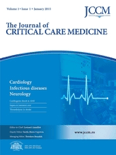
Journal of Critical Care Medicine
Advancing critical care knowledge for a healthier tomorrow.The Journal of Critical Care Medicine, published by SCIENTO, is a pioneering open-access journal dedicated to advancing the field of critical care, emergency medicine, anesthesiology, and pulmonary medicine. Since its inception in 2015, this journal has made significant strides in fostering knowledge dissemination and scholarly communication within the medical community. With an ISSN of 2393-1809 and an E-ISSN of 2393-1817, it provides a platform for high-quality research that impacts clinical practices and improves patient outcomes. Currently ranked in the second and third quartiles across multiple categories such as Critical Care and Intensive Care Medicine, and Emergency Medicine, the journal’s impact is underlined by its inclusion in prestigious databases like Scopus. The journal’s commitment to open-access publishing ensures that vital research is accessible to a wider audience, enriching the global dialogue in critical care practices. Researchers, healthcare professionals, and students seeking to remain at the forefront of this rapidly evolving field will find an invaluable resource in the Journal of Critical Care Medicine.